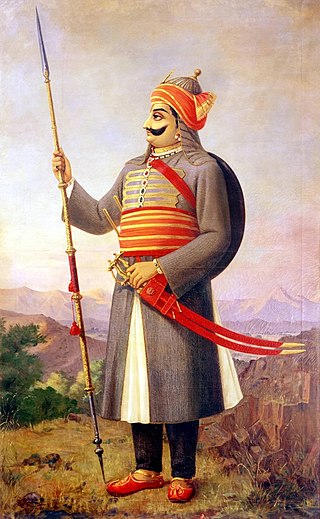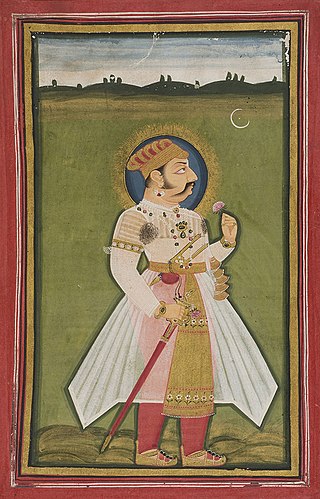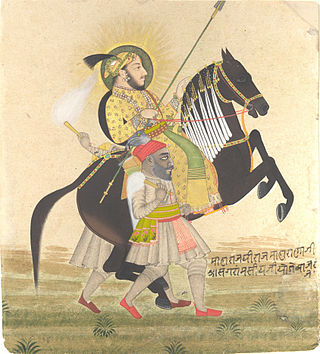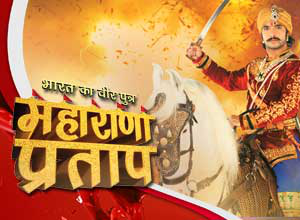
Pratap Singh I, popularly known as Maharana Pratap, was a king of Kingdom of Mewar, a princely state in north-western India in the present-day state of Rajasthan. He is notable for leading the Rajput resistance against the expansionist policy of the Mughal Emperor Akbar including the Battle of Haldighati.

Rana Kumbha or Kumbhkaran Singh (1433–1468), popularly known as Maharana Kumbha, was the ruler of the Kingdom of Mewar. He belonged to the Sisodia clan of Rajputs. It was during his reign that Mewar became one of the most powerful political powers in northern India. He is said to be the most potentially stabled sovereign of his time and his dynasty in general.

The Kingdom of Mewar, sometimes known as Udaipur State, was an independent kingdom in Rajputana region of India, ruled by the Sisodia dynasty. It was established around the 6th century by the minor rulers of the Nagada-Ahar region of Udaipur and later, in the 10th century, it transformed into an independent state under Rawal Bharttripatta II.

Kingdom of Marwar, also known as the Jodhpur State under the British, was a kingdom in the Marwar region from 1243 to 1818 and a princely state under British rule from 1818 to 1947. It was established in Pali by Rao Siha, possibly a migrant Gahadavala noble, in 1243. His successors continued to struggle against regional powers for domination and 9 out of 15 rulers till 1438 died in combat. In 1395, its capital was changed to Mandore by Rao Chunda of Mandore and to Jodhpur in 1459 by Rao Jodha.
Raimal Singh Sisodia, also known as Rana Raimal, was a Hindu Rajput ruler of Mewar. Maharana Raimal was the son of Rana Kumbha and his Rathore queen, a princess of Idar.
The Mughal–Rajput wars were a series of battles between the Rajput Confederacy and the Mughal Empire. The conflicts originated with the invasion of northwestern India by the Mughal ruler Babur, to which the head of the Rajput confederacy, Rana Sanga, offered staunch resistance.

Maharana Pratap: The First Freedom Fighter is an Indian epic film based on Maharana Pratap of Mewar .The film is directed and produced by Dr. Pradeep Kumawat from Udaipur, Rajasthan. It is the first time that a film has been made on the history of Maharana Pratap. The film's sound track includes one of the last songs sung by Late Jagjit Singh.

Maharana Sangram Singh II was the ruler of Kingdom of Mewar. He reigned from 1710 to 1734. He was succeeded by his eldest son Jagat Singh II.

Bharat Ka Veer Putra – Maharana Pratap is an Indian historical fiction series produced by Contiloe Entertainment. It is based on the life of Maharana Pratap, a sixteenth century ruler of Mewar kingdom. It starred Sharad Malhotra, Rachana Parulkar, Faisal Khan and Roshni Walia.

Maharana Amar Singh I, the Maharana ruler of Mewar Kingdom, was the eldest son and successor of Maharana Pratap I.He was the 14th Rana of Mewar,ruling from January 19, 1597 till his death on January 26, 1620.
Rana Lakha was the Sisodia Rajput ruler of Mewar Kingdom .He was the son of Rana Kshetra Singh and ruled Mewar from 1382 until his death in 1421.

Rao Chandrasen (1562-1581) was a Rathore Rajput ruler of the Kingdom of Marwar.He was a younger son of Rao Maldev Rathore and younger brother of Udai Singh of Marwar.Rao Chandrasen followed his father's policy and stayed hostile to the ruling foreign powers in north India. He is remembered for resisting the territorial expansion of the Mughal Empire in Marwar.

The Battle of Gagron was fought in 1519 between Mahmud Khalji II of Malwa and Rajput Confederacy of Rana Sanga. The conflict took place in Gagron and resulted in Sanga's victory, with him taking Mahmud captive and annexing significant territory.
Shakti Singh Sisodia Mewar was the son of Maharana Udai Singh II Sisodia and Rani Sajja Bai Solanki. He was a Kshatriya Rajput and was younger brother of famous Maharana Pratap, He was also the eponymous founder of the Shaktawat clan of Sisodia Rajputs.
Hansa Bai was Rani of the Rajput kingdom of Mewar during the early 15th century. She was the wife of Maharana Lakha Singh and mother to his heir, Mokal.
Prithviraj Sisodia, generally known as Kunwar Prithviraj, was the eldest son of Maharana Raimal of Mewar and heir apparent of Mewar, of the Sisodia Rajputs. His mother was Jhali Rani Ratan Kanwar. His rapidity of moving from one place to another and lightning speed of attack earned him the title of Udno Prithviraj, the flying Prithviraj. He added the regions of Godwar and Ajmer to the territory of Mewar.
Sauda is a clan of the Charanas. They are also known as Sauda-Barhath. Sauda Charans came to prominence in the kingdom of Mewar with the establishment of Sisodia dynasty in 1326.
The Battle of Ranakpur (Ranpur) was fought between the Mewar and the Mughal Empire

The Mewar- Malwa conflict was a series of wars between the Kingdom of Mewar and the Islamic Sultanate of Malwa. The conflict erupted due to mutual territorial expansion triggered by both sides on each other. The war was fought in what is now known as the Indian states of Rajasthan and Madhya Pradesh. The Rana branch of the Guhilas, following their successful recovery of the Rajput stronghold of Chittorgarh and the entire region of Mewar alongside Rajputana after the Battle of Singoli, embarked on an ambitious expansion at the cost of their neighboring kingdoms. On the other side, with the invasion of Timur, the Lame Delhi Sultanate grew weak with its multiple subahs gaining independence which included Malwa, adjacent to Mewar.










